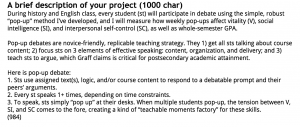In case you haven't heard, Character Lab is now accepting proposals for a new year of the Teacher Innovation Grant (TIG). You can learn more about TIG here, or just read these bulleted highlights:
- What you need to provide prior to the 11/2/15 deadline:
- an idea for developing one or more character strengths in your classroom;
- a willingness to design a research study around your idea. [1]
- What you receive as one of Character Lab's Teacher Innovators (besides $10,000):
- incredible PD from Character Lab (they are staffed by passionate geniuses and led by MacArthur “Genius Award” recipient Angela Duckworth, of TED talk and How Children Succeed fame);
- the opportunity to develop a real-deal research study around something you do in your classroom;
- additional money for any materials required for your project;
- a chance to share your work with a broader audience after your project is complete.
In short, it's incredible.
To help encourage you to share your idea for building character in your students, I've prepared a special list for you.
6 reasons people don't apply for the Teacher Innovation Grant
I've heard these reasons from smart folks who hesitate to apply; below each, please see my thoughts and advice.
 1. Up to a mere seven proposals will win, but hundreds will apply. There's no way I'll win. It's not worth it!
1. Up to a mere seven proposals will win, but hundreds will apply. There's no way I'll win. It's not worth it!
When I set out on the TIG quest last fall, I told myself the same thing I did when I began this blog: there was no way it would be a waste of time if I set both “moonshot” and “can't miss” goals. Your moonshot goal in applying for this grant is that you'll win! You'll get this awesome PD experience, you'll get to meet Dr. Angela Duckworth, and you'll get cash-money!
But there are some hugely valuable “can't miss” goals, too.
For example, going through the application process is bound to help you clarify your thinking around something you do in your classroom. Clear thinking yields better, saner teaching. View this as a chance to reflect on what you do and communicate it as best you can.
If all you have is the moonshot goal, then I agree — it may not be worth going through some drafts in the proposal-preparation process. But if you've got some “can't miss” goals as well, then this is a no-brainer.
Also: new this year is the fun fact that all finalist proposals (up to 20) will receive $250 mini-grants. Booyah!
2. I don't have time, man!
If you don't count the years in which I taught argument and character to my students prior to applying for the TIG, then the TIG application process didn't take much time. Here's how I spent my time in preparing for Round 1; each of these is on separate days (because you figure stuff out in your sleep):
- 1 hour brainstorming with like-minded, character-teaching colleagues in my school. Each of us spent 15 minutes or so being the focus of the group's conversation. The goal here was to come up with viable ideas, not perfect ones.
- 1 hour drafting my proposal, trying to be as concise as possible. (See #6!)
- 1 hour re-reading and reducing my first draft. I printed it out, grabbed a marker, and aimed for clarity clarity clarity and brevity brevity brevity. When finished, I made my handwritten changes to the digital version.
- Repeat. Draft the other elements of the application as well. There are two biographical bits (see the application here). While this stuff is important, it's nothing next to your idea.
- Repeat.
- Fill out the application and click submit. Sleep well because you did your due diligence, fought your inner editors, defied your insecurities, and went for something. Tell your students about it because you're a great role model.
All in all, I probably put 5 hours into the first round of applying — again, though, that's not counting the years that I've been thinking about and wrestling with teaching character alongside my colleagues. It will take longer — and be much harder — if you've not been doing likewise.
3. My idea isn't good enough!
If you are doing something in your classroom that you have reason to believe builds a character strength in students, then you're idea is good enough.
4. But Dave, my idea's not fancy!
Look at last year's winners. There is a lot of not fancy there. This is because, as Character Lab communicates again and again and again in their communications to would-be applicants, the goal here isn't to give grants to a bunch of really complicated ideas — the goal is to give grants to folks who have an idea that could be replicated by single, passionate teachers in classrooms around the country and world.
Boom.
So, friend, I see your not-fanciness
and say, “C'mon — apply.”
5. My idea is something I teach alongside my regular curriculum — it's not a special extracurricular unit or anything.
Actually, that's sweet, because Character Lab loves “dual-purpose” activities. Here's their elaboration on that, from the Teacher Innovation Grant FAQ page:
Some examples of dual-purpose ideas include a procedure you use to help your classroom run smoothly which also reinforces a character strength, or a lesson which teaches a particular subject you need to teach your students while also giving them practice exhibiting a character strength.
Again, last year's winners offer some examples of dual-purpose ideas:
- Susan was already going to teach The Scarlet Letter; her unit, she realized, was a great time to teach perspective, too.
- Ashley already teaches her students Ultimate Frisbee; it turns out that Ultimate's “ref yourself” rules are great at teaching fairness, too.
- I already teach argument, and much of that work is done through Pop-Up Debates; it just so turns out that PUDs are, I think, a great way to teach social intelligence, vitality, and persistence, too.
- Anna Maria has been wrestling with math-anxious kids for years; it turns out that her math patronus idea also has a great shot at producing measurable gains in bravery, too.
6. 1,000 characters to explain my whole idea? Are you ____ing kidding me?
Easy with the language, friend. This is probably the hardest (and smartest) thing about the application: you get 1,000 characters to make it happen. Here was my first round application last year (See Fig. 1).

Some things to notice:
- Abbreviation is your friend. Use it for those repetitive, pesky, character-devouring nouns.
- Abruptness is okay. Your reader understands that 1,000 characters is tight. They'll forgive your lack of essay-like transition sentences.
- This is a final draft. My first draft was at least double the length. When cutting it down, I had to keep telling myself that the goal of Round 1 is to make it to Round 2! In Round 2, you'll get to lay out way more of the nitty gritty details; in Round 1, you just need to give application readers a clear idea of what you're talking about. You need to make them feel the ol', “Oh, I want to hear more!”
You're invited! A free, informative webinar on a related topic
Next Wednesday (October 7) at 4pm EST, I'm developing my Internet skills and hosting a free webinar titled “Writing (and Getting) Grants.” It will be helpful for folks interested in applying for this year's TIG as well as those wanting to hear my thoughts on effective grant-writing in general. The tips I'll share apply more broadly, too — for example, I think they make me better at teaching and writing.
(If the 4pm EST timeslot doesn't work for you, a recording will be available to all who sign up.)
Footnote:
- Character Lab's wonderful Michelle McNamara is your “consultant” in this endeavor; this has proven the most valuable part of the experience for me, as she has coached me from rough concept to carefully designed study; she also did the legwork of finding valid measures for the strengths I'm interested in and a million more things. #grateful[hr]
Thank you to Tanya Ramm for emailing my colleagues and I about a year ago with the Character Lab TIG opportunity. Were it not for Tanya, I would not have heard about this, and I wouldn't be in the midst of the PD experience of my dreams.
Leave a Reply